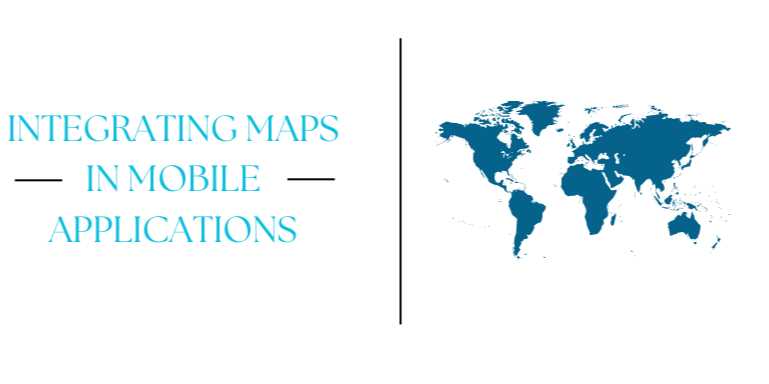Integrating Maps in Mobile Applications

📘 Chapter 5: Offline Maps, Performance, and Customization
While internet-connected maps dominate the mobile
experience, real-world use cases often demand offline functionality—like
navigating remote areas, traveling without data access, or ensuring reliability
in critical environments. Along with offline support, performance
optimization and UI/UX customization are key for delivering seamless,
responsive map interactions.
In this chapter, you’ll learn how to:
- Enable
and implement offline maps
- Optimize
performance for low-end devices and battery life
- Customize
map styles, markers, and behavior
- Reduce
data and memory usage in map-heavy screens
- Use
tile caching, clustering, and lazy rendering techniques
We’ll cover implementations for Android (Google
Maps/Mapbox), iOS (MapKit/Mapbox), and cross-platform approaches.
🗺️ 1. Introduction to
Offline Maps
Offline maps allow your app to function without an
internet connection by:
- Storing
map tiles and layers locally
- Allowing
interaction like pan, zoom, or search
- Supporting
offline routing or navigation (in some SDKs)
Offline functionality is critical for:
- Travel
apps
- Field
service or utility apps
- Emergency
services
- Rural
or disconnected environments
✅ 2. SDK Support for Offline Maps
|
SDK / Feature |
Offline Map
Support |
Notes |
|
Google Maps SDK |
❌ Limited |
Caches recently viewed
tiles only |
|
Mapbox SDK |
✅
Full |
Downloadable
regions, tile packs |
|
HERE SDK |
✅ Full |
Offline tiles,
routing, geocoding |
|
Apple MapKit |
❌
No native support |
Use with
hybrid caching solutions |
|
OpenStreetMap |
✅ (via plugins) |
Requires tile packs or
mbtiles integration |
🧰 3. Implementing Offline
Maps with Mapbox
✅ Android – Download Offline
Region
Add dependency:
gradle
implementation
'com.mapbox.maps:android:10.13.0'
Setup offline region:
kotlin
val
region = OfflineRegionDefinition(
styleURL = Style.MAPBOX_STREETS,
bounds = LatLngBounds.Builder()
.include(LatLng(37.7749, -122.4194))
.include(LatLng(37.7849, -122.4094))
.build(),
minZoom = 12.0,
maxZoom = 16.0,
pixelRatio = 1.0f
)
offlineManager.createOfflineRegion(region,
byteArrayOf()) { offlineRegion ->
offlineRegion.setObserver(...)
offlineRegion.download()
}
✅ iOS – Mapbox Offline Pack
swift
let
region = MGLTilePyramidOfflineRegion(
styleURL: MGLStyle.streetsStyleURL,
bounds: bounds,
fromZoomLevel: 10,
toZoomLevel: 14
)
MGLOfflineStorage.shared.addPack(for:
region, withContext: Data(), completionHandler: { (pack, error) in
if let pack = pack {
pack.resume()
}
})
⚙️ 4. Performance Optimization
Techniques
Performance is crucial for smooth map rendering, especially
on:
- Older
or low-RAM devices
- Apps
with 1000+ map points
- Background
location tracking apps
🔹 General Tips
- Avoid
unnecessary animations or rapid camera updates
- Use
vector maps instead of raster for performance
- Load
markers lazily (based on visible bounds)
- Use
GPU-accelerated layers for overlays
🔹 Android-specific
- Use TileOverlays
for better caching
- Use LiteMode
on older devices:
kotlin
val
options = GoogleMapOptions().liteMode(true)
- Throttle
onCameraMove listeners to avoid redraws
🔹 iOS-specific
- Avoid
excessive overlays
- Debounce
frequent regionDidChangeAnimated triggers
- Use
MKTileOverlay for custom tile layers
🗂️ 5. Custom Map Styles
and Themes
✅ Google Maps Custom Styling
- Use
Google Maps Style Wizard
- Export
JSON and apply:
kotlin
mMap.setMapStyle(MapStyleOptions.loadRawResourceStyle(this,
R.raw.map_style))
✅ Mapbox Studio
- Offers
full control over layers, colors, fonts, icons
- Export
and use styleURL:
kotlin
mapboxMap.loadStyleUri("mapbox://styles/yourusername/styleid")
✅ iOS MapKit Customization
- Limited
styling
- Can
customize annotations, polylines, overlays manually
- Use
MKTileOverlay to layer map data or apply external tiles
📍 6. Marker Optimization
for Large Datasets
Rendering 1000+ markers can freeze maps without
optimizations.
✅ Solutions
|
Strategy |
Description |
|
Clustering |
Combine nearby markers
into clusters |
|
Lazy Rendering |
Only load
markers within visible camera bounds |
|
Tile Overlays |
Render static map
layers from backend data |
|
MinZoom Filtering |
Only render
complex markers above zoom level |
🧪 7. Tile Caching and
Bandwidth Optimization
- Google
Maps caches tiles automatically but doesn't guarantee persistence
- Mapbox
and HERE allow preloading tile packs
- Use
vector tiles to reduce data size
- Compress
downloaded map regions (gzip/tar)
🔋 8. Battery-Saving Tips
for Map-Heavy Apps
|
Technique |
Benefit |
|
Reduce update
frequency |
Saves CPU &
battery |
|
Disable gestures when idle |
Stops
unnecessary rendering |
|
Avoid background
animations |
Prevents wake locks |
|
Use Wi-Fi-only downloads |
Conserves
mobile data |
|
Pause updates in
background |
Saves resources |
📊 Summary Table: Feature
Support Across SDKs
|
Feature |
Google Maps |
Mapbox |
HERE Maps |
Apple MapKit |
OSM |
|
Offline Maps |
❌ (limited) |
✅ |
✅ |
❌ |
✅ |
|
Custom Styles |
✅
(JSON) |
✅ |
Moderate |
Limited |
Manual |
|
Tile Caching |
Auto |
✅ |
✅ |
❌ |
✅ |
|
Marker Clustering |
✅ |
✅ |
✅ |
Manual |
✅ |
|
Vector Support |
✅ |
✅ |
✅ |
✅ |
Limited |
|
Performance Mode |
Lite Mode |
Yes |
Yes |
N/A |
N/A |
📌 Conclusion
Offline maps and smart performance strategies are essential
in making map-based apps reliable, efficient, and delightful. Whether
you're reducing network load or crafting a branded visual experience, the tools
are all within reach—if chosen and implemented thoughtfully.
In the final chapter, we’ll wrap up the series with Security,
Privacy, and Store Compliance, ensuring your app meets legal, ethical, and
platform guidelines for handling location data.
FAQs
❓1. What are the most popular APIs or SDKs for integrating maps in mobile apps?
Answer:
The most popular options are:
- Google
Maps SDK for Android and iOS
- Apple
MapKit (iOS/macOS)
- Mapbox
SDK (cross-platform)
- HERE
SDK
- OpenStreetMap
(with third-party libraries)
Each offers unique features such as offline maps, customizable styles, routing, and geofencing.
❓2. Do I need an API key to use Google Maps in my app?
Answer:
Yes. You must create a Google Cloud Platform project, enable the Maps SDK, and
generate an API key. This key must be included in your app's configuration and
is used to monitor usage and billing.
❓3. Can I use maps in both Android and iOS using a single codebase?
Answer:
Yes. Frameworks like Flutter (google_maps_flutter), React Native
(react-native-maps), and Ionic/Capacitor allow you to integrate maps
across both platforms using a single codebase while still accessing native
performance and features.
❓4. How can I track a user’s real-time location?
Answer:
Use location services like:
- FusedLocationProviderClient
(Android)
- CLLocationManager
(iOS)
- Geolocator
(Flutter) These services provide GPS-based updates which can be fed into
your map widget to reflect movement in real time.
❓5. How do I handle location permission requests correctly?
Answer:
- Always
request permissions contextually (i.e., when the feature is needed)
- Use
pre-permission prompts to explain why the location is needed
- Implement
graceful fallbacks when permissions are denied
- Follow
platform-specific guidelines (ACCESS_FINE_LOCATION,
NSLocationWhenInUseUsageDescription, etc.)
❓6. What’s the difference between MapKit and Google Maps SDK?
Answer:
MapKit is Apple’s native mapping framework with seamless iOS
integration, while Google Maps SDK offers more advanced features like
street view, better global coverage, and dynamic routing. Google Maps is
preferred for cross-platform apps, while MapKit is great for iOS-only apps.
❓7. Can I create custom map markers and popups?
Answer:
Yes. All major SDKs (Google Maps, MapKit, Mapbox) support:
- Custom
icons/images for markers
- Info
windows/popups
- Click
or long-press events for user interaction
This allows you to personalize map interactions and branding.
❓8. Are offline maps possible?
Answer:
Yes, but not all SDKs support them by default. Mapbox, HERE Maps,
and Google Maps (via caching) allow for offline functionality, often
with a file size and usage limit. Offline maps are useful in areas with poor
connectivity.
❓9. How can I show directions or routes between two points?
Answer:
Use services like:
- Google
Maps Directions API
- MapKit’s
MKDirections
- Mapbox
Navigation SDK
These provide polyline paths, distance, estimated time, and navigation instructions between locations.
❓10. What privacy considerations should I follow while integrating maps?
Answer:
- Inform
users before collecting or using location data
- Request
the minimum necessary permissions
- Anonymize
or encrypt stored location data
- Clearly
outline usage in your Privacy Policy
- Follow
GDPR, CCPA, and platform-specific policies like Apple’s App Tracking
Transparency (ATT)
Tutorials are for educational purposes only, with no guarantees of comprehensiveness or error-free content; TuteeHUB disclaims liability for outcomes from reliance on the materials, recommending verification with official sources for critical applications.
Explore Other Libraries
Related Searches
Please allow ads on our site
Kindly log in to use this feature. We’ll take you to the login page automatically.
Login
Join Our Community Today
Ready to take your education and career to the next level? Register today and join our growing community of learners and professionals.

Your experience on this site will be improved by allowing cookies. Read Cookie Policy
Your experience on this site will be improved by allowing cookies. Read Cookie Policy

Comments(0)